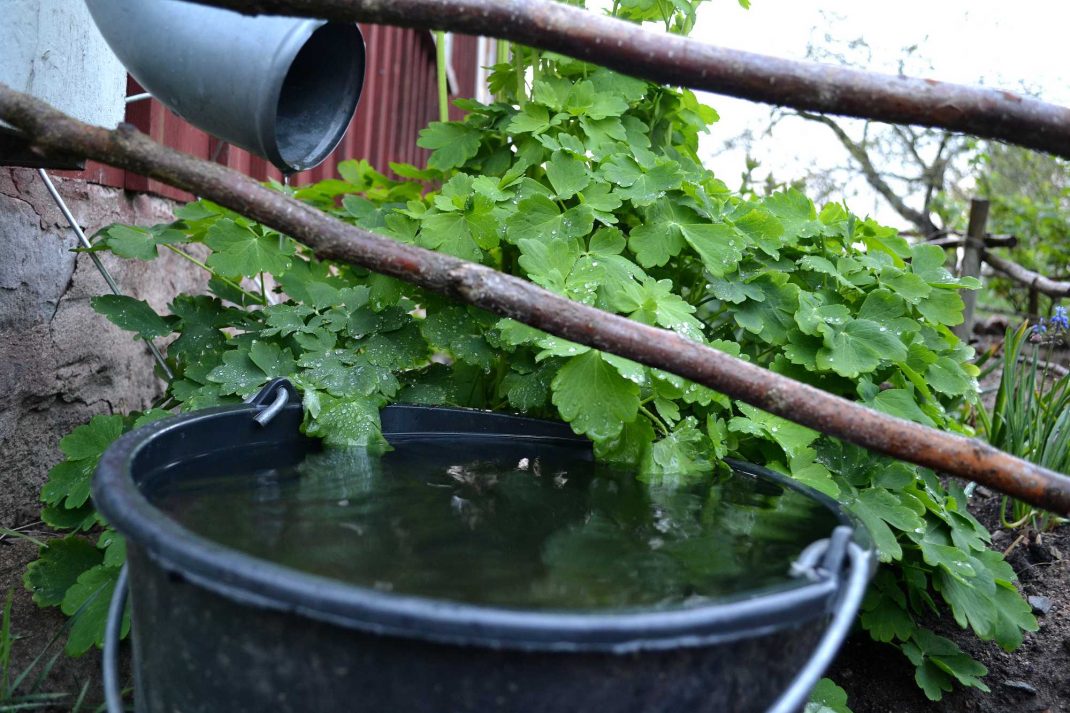5 water-saving tips for your garden
We get the water here at home from our private well. It works really well most of the time, but we sometimes run low. That's when I need to really apply my best water-saving strategies.

A simple bucket does the job of collecting rainwater for now.
I keep worrying about not having enough water. If you live in an apartment or house in a densely populated area, you might not think much about it. The water will keep coming even if there were to be a temporary shortage.
Water shortage in the countryside
We live in the countryside with our own private well. It's 650 feet (around 200 meters) deep and generally quite reliable. But the water quality changes if we have had a dry winter and spring. The water can start to look brown in summer and it smells a bit like dirt.
A well can, of course, run dry. It could happen to us too. And if it does, we have a problem. It's strange. We talk about what we would do if the food runs out or there's a power shortage. But we very rarely discuss the water. If there' s a power shortage, we no longer have a functioning water pump. We try to be smart and find new water-saving strategies already now in spring.
Read more about watering: Fertilize with nettle water
Water-saving tips for the garden
The garden does, of course, require quite a lot of water. You might even wonder if it's reasonable to have a large vegetable garden when you might run out of water. Well, I think it actually is. In the big picture, my garden is actually very resource-efficient compared to a large commercial garden. But I will, of course, have to cut down on the watering when the well is in a bad state. That's why it's so important to find new water-saving strategies and getting my plants used to the new circumstances.
My 5 best tips
1. Pre-seed as many vegetables as possible. You don't need as much water for the troughs of pre-seeded vegetables as you do for beds outside. The water might also not sink into the soil if it's too dry, and you need to water new sowings more often. So, try starting your seeds in pots and plant outside later instead.
2. Use plenty of water when you plant your vegetables. If you make sure to use a lot of water as soon as you put the plants in the soil, they actually do quite well even in a dry summer. This trick works extra well if you use it with the next one on my list...
3. Mulch. Put grass clippings, old leaves, silage or other plant parts on top of your soil. This will keep the water from evaporating from the bed even in dry summers. This is probably the most important thing we can do to save water. So keep mulching!
4. Water smaller areas. Use a watering can to water individual plants instead of using a hose or a sprinkler over a larger area.
5. Collect rainwater. When it rains, it pours. And I make sure to save it! You can collect water from the rain gutters, the greenhouse roof, etc. Try googling "how to collect rainwater" for more inspiration. You could also go to your local hardware store to find the tools you need to collect rainwater from your gutters.
More about watering: How to water large plants
There are plenty of things you can do to save water even if you have a large vegetable garden at home. It's important to remember that some vegetables might grow slower and smaller because of the lack of water. I try to fix this problem simply by growing a little bit more than I think I need. This way, I can afford to lose vegetables and I won't end up with an empty pantry.
Another really important aspect of growing a water-wise garden is to grow all year round. Growing all year round means that I can harvest vegetables when we naturally have more rain, for example in fall, early winter and spring. Growing all season long will not only help me take advantage of the full capacity of the soil, but it's also a great water-saving strategy.
/Sara Bäckmo



Leave a Reply
You must be logged in to post a comment.